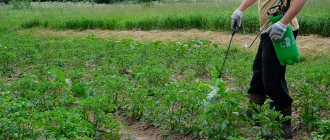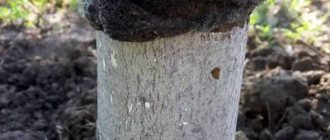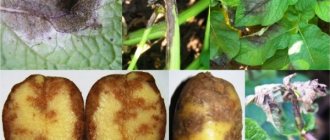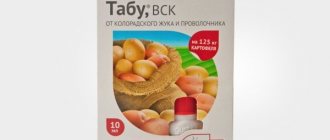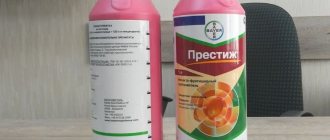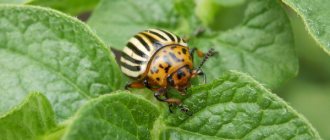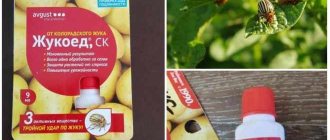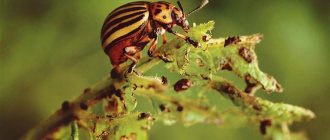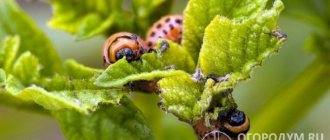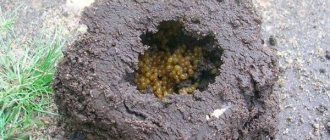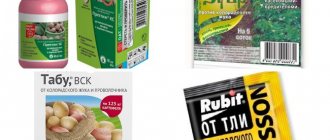The Colorado potato beetle is more capable of harming potatoes than any other insect.
Colorado potato beetle destroying potato bush
The voracious larvae eat up all the leaves within a few days, leaving only the stems.
In order not to be left without a harvest, you will need to treat potato seeds against the Colorado potato beetle: we will tell you in this article how and what is the best way to treat potatoes.
Pre-sowing treatment - a barrier to pests
In the spring, when the soil thaws, the pests that hibernate in it wake up. They are actively looking for a power source. Insects living in the soil are content with the hard roots of perennial grasses - nettle, burdock, dandelion, wheatgrass. After all, there are no more delicious young plants yet. But with the arrival of gardeners to the plots, the real feast begins. We ourselves bring food to the pests: we sow root crops, plant seedlings. But potatoes are the first to come under attack, since at the time of planting the plants have not yet grown from the seeds, and it is too early to plant seedlings.
The wireworm makes its way to the feeding site
As soon as the tubers are in the ground, soil pests move on to them. They feed on juicy sprouts and sweet young roots, and bite into the inside of potatoes. Fortunately, every seed potato has several sprouts. Out of 5-6, 2-3 will remain undamaged, they will germinate and give us a harvest. Meanwhile, the insects remain in the field and continue to feed on stolons and young nodules. The bush loses strength and does not produce the expected harvest. We would get a lot more if we didn't share with pests. Pre-sowing preparation makes potatoes unattractive, tasteless and even poisonous for wireworms, mole crickets and Colorado potato beetles that have become hungry over the winter.
Biological products
Insecticidal biologics have recently been developed as an alternative to harmful chemical insecticides. They are capable of destroying the beetle and its larvae without causing harm to warm-blooded animals, fish, bees, reptiles and humans.
They leave absolutely no traces in groundwater, soil or harvested crops, making them suitable for processing early varieties.
Biological products are based on the ability of microorganisms, which are natural antagonists, to suppress the vital functions of insect pests that devour young shoots.
The action of biological products is targeted and targeted, it guarantees harmlessness to the environment and the resulting crop.
In addition, tubers receive a powerful stimulus for growth - biological products act as biological fertilizers that can increase yields by a third.
Treatment with biological products consists of a series of simple actions with potatoes before planting.
Important! A significant disadvantage is the need to additionally spray the seedlings regularly, once every 2 weeks.
“NO Colorado potato beetle!”
The biological product from B-actif, based on Indian Azadirachta oil in combination with nitrogen, is aimed at blocking the reproduction function of pests in adults, and at blocking nutrition, growth and development in larvae.
The product is supplied with microelements that are beneficial for potatoes, the main one being natural nitrogen, so the harvest is healthy and abundant.
How to treat potatoes before planting against wireworms
Wireworms are the larvae of a large click beetle, colored black or brown. The body length can reach 6 cm. And although they write that this pest leads a secretive lifestyle, encountering it in an infested area is not uncommon. As soon as you start working with the soil: loosening it, making holes, this insect will definitely jump out of its destroyed burrow and busily run to build a new one. The beetle moves deftly and quickly, and once on its back, it does a somersault and turns over, making a click. The clicker got its name for this ability.
One type of click beetle. There are more than 10,000 of them in total
Females emerge from wintering at the end of April and lay eggs under lumps of earth. Small yellow larvae emerge from the eggs; they live in the ground and grow for 2–5 years (depending on the species). They feed on the roots of wild herbs, tubers and root crops. The larvae make numerous tunnels in potatoes. It’s easier to throw away such tubers than to clean them. Adult wireworms up to 4.5 cm long with a hard body are ready to turn into beetles. At the end of summer they climb to a depth of 15 cm, make a cradle and pupate.
Prevention of wireworms with harmless means:
- onion peels - a handful in each hole during planting;
- dry mustard - powder the soil in the hole with it, you can add hot pepper;
- green manure - sow mustard or lupine seeds in rows, along the perimeter of the field or between holes, mow them during the flowering period and place them as mulch;
- ash, dolomite flour, fluff lime - all these are alkalis, and wireworms love acidic soil, scatter the products before digging or add a tablespoon to the hole and mix with the soil;
- potassium permanganate - 5 g per 10 liters of water, pour 0.5 liters of solution into each well;
- birch tar - dilute 1 tbsp. l. in 1 liter of water, dip each tuber, before planting, also pour the holes, but with a less concentrated solution - 1 tbsp. l. on the watering can.
When to spray potatoes
Since beetles are very fond of delicate potato flowers, and it is during flowering that the future harvest is laid, the optimal time for spraying is before and after flowering. If pests are found on flowers, it is better to collect them manually or use safe traditional methods, and put chemicals aside for now.
So spraying can be carried out when the first shoots appear and then every 2-3 weeks until flowering. The next time the treatment is carried out after flowering.
Also, the time of the procedure is morning or evening in cloudy, dry weather, when there is no wind.
Description of the bear and pre-landing protection against it
A large burrowing insect up to 8 cm long with a dark brown back and olive abdomen lives in the ground, but can swim, jump, fly, and at night makes trills and chirps that are louder than the singing of a cricket or grasshopper. The pest has powerful jaws and front paws, which allow it to build underground passages and oval chambers (nests). There is a shell on the neck, in which the head is partially hidden, and the abdomen ends with two thread-like appendages. The eyes are clearly visible on the head, and there are antennae.
Amateur naturalists catch mole crickets and keep them together with the larvae in insectariums and observe their development. For some, mole cricket breeding is a business because there is a belief that these insects help cure tuberculosis and cancer.
The mole cricket lives underground, but can fly at an altitude of up to 5 meters
In summer, the female lays eggs, from which small mole crickets emerge. At first they look like grasshoppers. In the southern regions, young offspring become sexually mature in the same year, and, for example, in the Leningrad region, the full development cycle lasts 2–2.5 years. Pests are omnivores, they feed on everything that gets in their way when building burrows: beetles, worms, plant roots, and they love to feast on root vegetables and young potatoes.
Recommendations and tips for spraying
Simple tips and recommendations from experienced gardeners will make the fight more effective.
- Potatoes should be treated against the Colorado potato beetle in dry weather without wind. In this case, the leaves of the plants must be dry.
- It is best to poison pests in the evening.
- To make the solution stick to the leaves (longer effect), add a little laundry or liquid soap to the working composition.
- After preparation, the solution is used within several hours. Over time, it loses its effectiveness.
- After each treatment, be sure to wash your hands and wash your clothes.
On a note!
The peculiarity of the pest is that the insect easily adapts to new stressful conditions, so the methods and preparations used are regularly changed.
How to treat potatoes before planting against the Colorado potato beetle
The homeland of this leaf beetle is Mexico, and it received its modern name in 1859, when it devastated potato fields in Colorado (USA). The pest crossed the Atlantic Ocean with cargo on ships and spread throughout Europe. Eastern winds in the summer helped hordes of beetles reach the borders of the USSR by the 1940s. Today, residents of all regions of the Russian Federation, including Siberia and the Primorsky Territory, are struggling with the pest.
The Colorado potato beetle is a guest from hot Mexico, adapted to the harsh climate of Russia
The Colorado potato beetle is similar in size and shape to a ladybug; the larvae of these insects are also similar, the only difference is in color. There are 10 stripes on the back of the beetle: 5 black and 5 yellow or orange. The larvae have a black head and a number of black dots on their sides. The pests overwinter in the ground, at a depth of up to 20 cm, emerge in the spring, begin to feed on young seedlings and reproduce. During the season, depending on the region, from one to three generations can grow. Newly born individuals feed on the pulp on the back of the leaves, while adults eat all the tops, leaving only the veins.
Biological drugs
Biological insecticides, which are less safe, are widely used by gardeners. After treatment, harvesting can be done within 7-10 days, as it does not accumulate in plant tissues.
The disadvantage of biological agents is that they destroy larvae of various ages and adult insects, but do not affect laid eggs. Therefore, treatments are performed up to 3 times per season.
Among the biological insecticides when combating the Colorado potato beetle, you can use:
- Bitoxibacillin;
- Fitoverm;
- Nemabact;
- Akarin;
- Anthonem-F.
Each of them has a different release form and duration of exposure. When to spray potatoes against the Colorado potato beetle and how to dilute it is indicated in the instructions for each product.
A brief overview of popular products for pre-planting treatment of potato tubers
| Drug name | Manufacturer | Pests to fight | Duration of protective action/waiting period in days |
| Prestige | Crop Science (Germany) | Wireworms, Colorado potato beetles, mole crickets, beetles, thrips, leafhoppers, flea beetles, moths. Also protects against scab, rot and rhizoctonia. | 30/60 |
| Taboo | August (Russia) | Wireworm, Colorado potato beetle | 45/60 |
| Nuprid 600 | Nupharm GmbH & Co KG (Austria) | Soil pests, Colorado potato beetle, May beetle larvae, aphids | 30–40/60 |
| Commander | AlfaKhimgroup (Russia) | Complex of soil and ground pests | 10/20 |
| Aktara | Syngenta (Switzerland) | Colorado potato beetle, aphids, thrips, mites, scale insects, etc. | 7–28/40–60 |
| Aktofit | Biovetapharm (Ukraine) | Colorado potato beetle, aphids, thrips, mites, white beetles, cutworms | 1/2 |
Modern technological methods to combat the beetle
Thanks to the development of genetic engineering, scientists have been able to develop special varieties whose tops contain toxins that are harmful to the Colorado potato beetle. But most pests soon became immune to the toxic substances contained.
Scientists and breeders have also developed special varieties that are distinguished by tough and hard tops that Colorado potato beetles do not eat.
Varieties that are least susceptible to the spread of the Colorado potato beetle:
- "Spark";
- "Pace";
- "Glow".
Advice from experienced gardeners
Experienced gardeners advise starting to fight the beetle as early as possible so that it does not have time to lay eggs. It is much more difficult to fight a brood of larvae. They eat leaves faster, slowing down plant growth. In addition, it is advisable to catch it before the flowers appear. The larvae cause significant damage by eating flowers. In this case, tubers may not set.
It is better to carry out treatment in the evening, since morning dew reduces the concentration of the active substance. When working with chemicals and bioinsecticides, it is necessary to use personal protective equipment: mask, goggles and gloves. But if there is a special suit, that’s good.
You also need to carefully monitor how toxic the drug is. During spraying and even after, it is necessary to limit the access of children, pets and bees.
Also, you cannot treat with the same drug every year; you need to at least alternate 2-3 products. Insects quickly develop immunity.
Do not spray or water before or immediately after rain, as it washes away the active ingredients. They do not have time to influence insects. And finally, dilute as much of the drug as is sure to be enough for the entire area. It cannot be stored.
